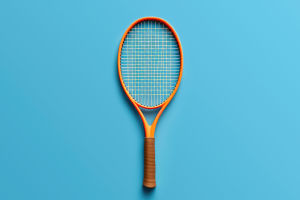Tennis is not only a fun and competitive sport; it's also a powerful full-body workout.
Engaging in a tennis match requires speed, endurance, coordination, and agility, which collectively activate and strengthen muscles throughout the body.
Unlike workouts that focus on specific muscle groups, tennis delivers a balanced combination of aerobic and anaerobic exercise, making it ideal for those seeking a total body workout.
The lower body plays a vital role in tennis, where quick footwork, directional changes, and sprints are essential. Every lunge, sidestep, and sprint across the court engages the quadriceps, hamstrings, and calves.
As you move side-to-side, your legs are forced to stabilize and react quickly, which builds muscle strength and improves agility.
When you sprint to reach a fast-moving ball or shift your body weight to change direction, you're not only building endurance in your legs but also activating your glutes.
Strong gluteal muscles are crucial for balance and explosive movements, and tennis drills like split steps and lunges can help strengthen them effectively. Over time, regular play can increase muscle tone in the legs, improving stability, speed, and overall lower-body strength.
Serving, forehand, and backhand shots rely heavily on the upper body, particularly the muscles in the arms, shoulders, and chest. Each time you swing your racket, you engage your deltoids, biceps, and triceps, as well as the pectoral muscles in the chest.
Repeatedly hitting the ball with power builds muscle endurance and strength, allowing you to hit harder and faster over time.
Moreover, each stroke involves twisting the upper body and extending the arms fully, movements that strengthen the shoulder muscles and stabilize the core.
Practicing various strokes helps improve coordination between your arms and shoulders, boosting both power and control in your shots.
The core is central to nearly every movement in tennis. Effective serves, volleys, and groundstrokes require strong core muscles to generate power and maintain balance.
When you twist your torso to hit a backhand or forehand, you engage the obliques, which contribute to rotational power and control. The lower back muscles also play a role in maintaining posture during these twisting motions.
A strong core is essential for balance and stability on the court. Each time you sprint, stop, or twist, your core muscles work to stabilize your movements, preventing falls and injuries.
Additionally, when you engage in the ready position, which involves a slight forward bend, you're activating your abdominal muscles and working the lower back. Regular tennis practice builds a strong, stable core, which translates to better performance and reduced risk of injury.
While tennis is effective for strengthening muscles, it also provides a fantastic cardiovascular workout. The sport combines short, intense bursts of activity with brief recovery periods, which is a form of interval training.
This mix of aerobic (endurance) and anaerobic (explosive power) exercise increases heart rate, improves lung capacity, and boosts overall cardiovascular health.
Interval training in tennis not only helps with muscle endurance but also supports faster recovery times, allowing players to sustain high levels of performance for longer periods. Over time, regular tennis play strengthens the heart and increases stamina, contributing to a healthier cardiovascular system.
Beyond physical fitness, tennis sharpens mental skills like focus, reaction time, and decision-making. The quick nature of the game requires constant awareness, and each shot calls for strategic thinking. Playing tennis not only strengthens muscles but also enhances cognitive abilities, leading to improved mental agility.
Playing tennis is an exceptional way to exercise muscles all over the body. The sport strengthens and tones muscles in the legs, arms, shoulders, and core while also delivering cardiovascular benefits and mental stimulation.
Whether you're a seasoned player or a beginner, tennis offers a balanced, full-body workout that can improve your fitness, endurance, and overall health.
Embrace the court, and experience the many ways tennis can enhance both your physical and mental well-being.


